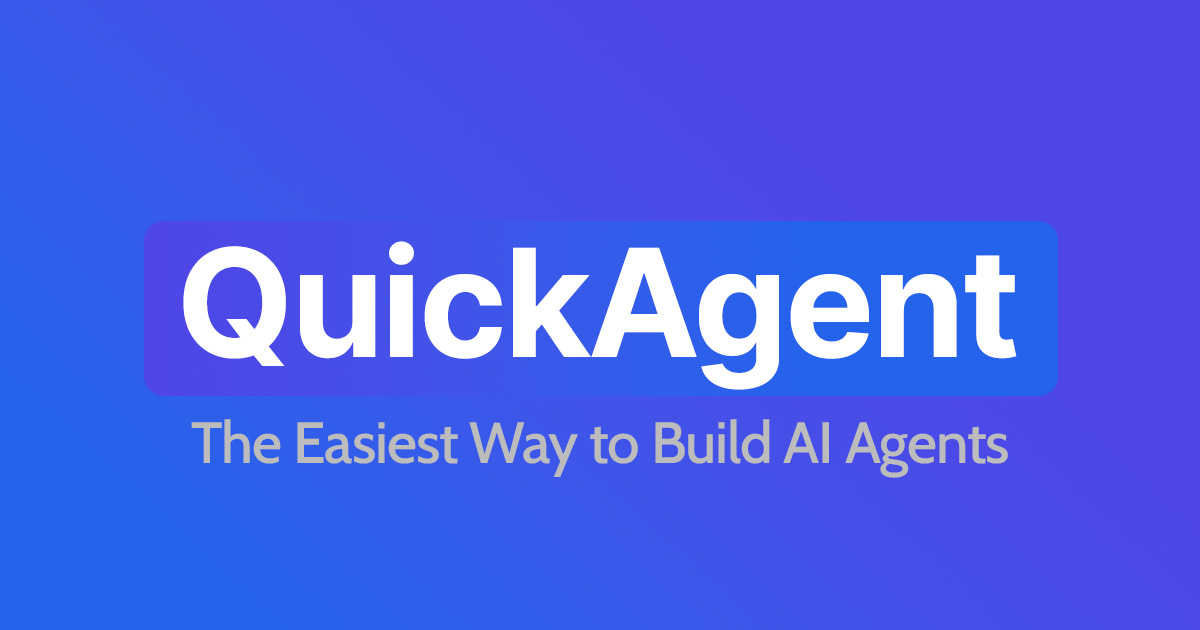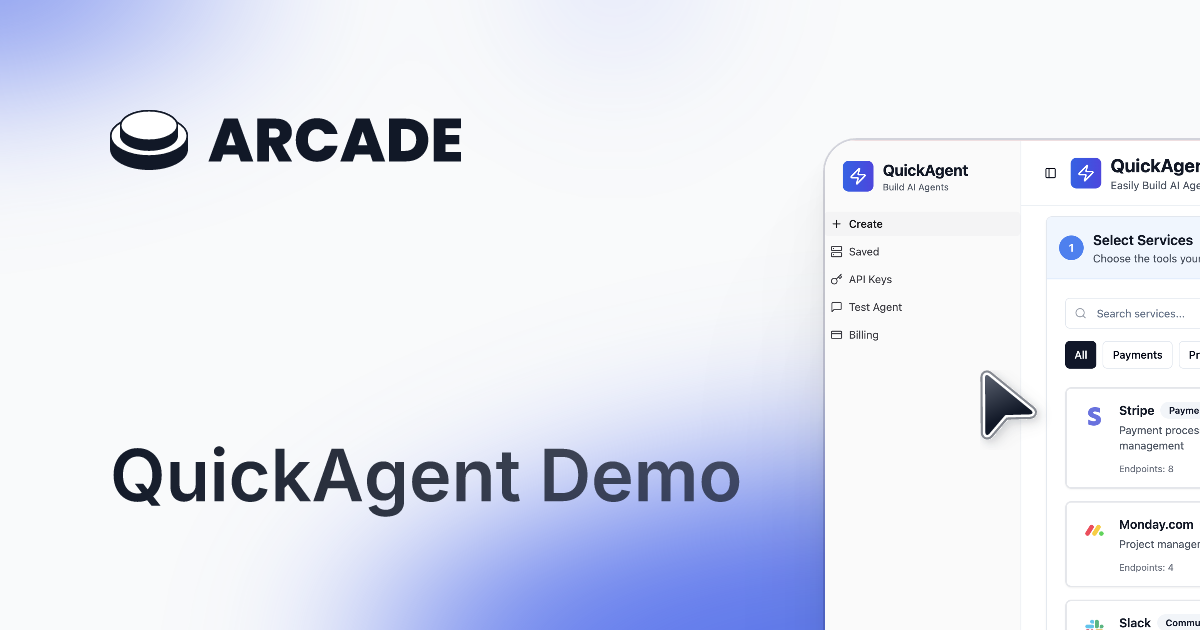
Table of Contents
Overview
In the rapidly evolving landscape of AI automation, the ability to deploy intelligent agents quickly and without extensive coding has become a strategic necessity. QuickAgent emerges as a comprehensive no-code solution, launched on Product Hunt in June 2025, that allows users to build AI agents capable of connecting to virtually any service. This innovative platform eliminates the complexities of coding and MCP server management, enabling businesses and individuals to integrate powerful AI capabilities with platforms like Stripe, Slack, and HubSpot instantly. With QuickAgent, organizations can deploy intelligent automation in minutes using a free-forever tier and pay-as-you-use pricing model.
Key Features
QuickAgent introduces a robust suite of features designed to democratize AI agent creation and streamline deployment workflows:
- No-code Visual Builder: Intuitive drag-and-drop interface that empowers users of all technical levels to design and configure sophisticated AI agents without writing code, featuring rule-based logic and conditional workflows.
- Instant Service Integrations: Out-of-the-box connections with popular business tools including Stripe, Slack, Gmail, HubSpot, and hundreds of other platforms, enabling rapid deployment and immediate operational utility.
- Custom API Integration: Following the successful launch, QuickAgent introduced the ability to configure AI agents with custom APIs, expanding beyond pre-built services to support unique business requirements and proprietary systems.
- Zero Infrastructure Management: Complete abstraction from server management, MCP protocols, and backend infrastructure complexities, allowing users to focus exclusively on agent logic and business functionality.
- Flexible Pricing Model: Free-forever plan for experimentation and learning, with transparent pay-as-you-use pricing that scales with actual agent consumption rather than upfront commitments or subscription fees.
How It Works
QuickAgent operates through an intelligent visual workflow system that abstracts complex AI automation into user-friendly components. Users interact with a sophisticated drag-and-drop interface, connecting pre-built service blocks and custom API endpoints to design their desired AI workflows. The platform’s underlying architecture handles authentication, data flow, and API management automatically. AI agents are powered by advanced language models that can interpret context, make decisions, and execute multi-step processes across integrated platforms. The entire deployment process is managed seamlessly, with QuickAgent handling scaling, monitoring, and error management without requiring user intervention.
Use Cases
QuickAgent’s versatility and ease of deployment make it valuable across diverse industries and automation scenarios:
- Customer Support Automation: Deploy intelligent agents that handle routine inquiries, provide instant responses using knowledge bases, escalate complex issues appropriately, and maintain conversation context across multiple touchpoints, significantly improving response times and customer satisfaction metrics.
- Sales and Marketing Automation: Automate lead qualification processes, personalize outreach campaigns based on customer data, manage follow-up sequences, generate dynamic content, and integrate with CRM systems to maintain comprehensive prospect tracking and nurturing workflows.
- Cross-Platform Workflow Orchestration: Connect disparate SaaS applications and automate complex multi-step processes, ensuring seamless data synchronization, task coordination, and business process optimization across organizational departments and external vendor systems.
- Intelligent Task Automation: Create specialized bots that perform repetitive operations within and between software applications, from automated data entry and report generation to compliance monitoring and inventory management, enhancing overall productivity and reducing human error.
Pros \& Cons
Understanding QuickAgent’s strengths and limitations provides insight into its current market position and operational capabilities.
Advantages
- Accessibility and Speed: The no-code visual builder eliminates technical barriers, enabling rapid agent creation and deployment within minutes, making AI automation accessible to non-technical business users and accelerating time-to-value.
- Comprehensive Integration Ecosystem: Broad compatibility with popular business applications combined with custom API support provides extensive flexibility for connecting existing technology stacks and proprietary systems.
- Cost-Effective Scaling: Free-forever tier enables extensive experimentation and learning, while usage-based pricing ensures organizations only pay for actual consumption, making it suitable for both startups and enterprise deployments.
- Community-Driven Development: Active development cycle with responsive feature additions based on user feedback, demonstrated by the rapid introduction of custom API capabilities following launch feedback.
Disadvantages
- Platform Maturity: As a newly launched platform, QuickAgent may still be developing advanced features and enterprise-grade capabilities compared to more established automation tools, potentially requiring patience during rapid development cycles.
- Customization Depth: While powerful for intended use cases, the no-code approach may offer less granular control and advanced customization options compared to code-first solutions or enterprise platforms with extensive configuration capabilities.
- Usage Cost Predictability: Although cost-effective initially, high-volume or complex agent interactions could result in escalating costs that may require careful monitoring and budget planning for large-scale deployments.
How Does It Compare?
When evaluating QuickAgent against the current landscape of AI automation and agent platforms in 2025, several key distinctions emerge:
- Lindy: While Lindy focuses on enterprise workflow automation with advanced AI capabilities and established enterprise features, QuickAgent emphasizes accessibility and rapid deployment for businesses of all sizes. Lindy offers more sophisticated enterprise integrations, while QuickAgent provides easier onboarding and cost-effective scaling.
- Relevance AI: Relevance AI specializes in low-code AI agent development with strong data labeling and analytics capabilities. QuickAgent differentiates itself with true no-code accessibility and instant integrations, making it more suitable for business users without technical backgrounds.
- n8n: n8n provides powerful open-source workflow automation with extensive customization options. QuickAgent offers a more user-friendly experience with managed infrastructure and AI-first design, while n8n requires more technical expertise but offers greater flexibility and control.
- Microsoft Copilot Studio: Microsoft’s platform provides 1,200+ data connectors and deep Microsoft ecosystem integration. QuickAgent competes with faster setup times, platform-agnostic approach, and more transparent pricing, making it attractive for organizations not heavily invested in Microsoft infrastructure.
- Make.com (formerly Integromat): Make.com excels at complex multi-step workflow automation with advanced logic capabilities. QuickAgent focuses specifically on AI-powered agent logic and simplified deployment, making it more specialized for AI-driven tasks rather than general workflow automation.
Final Thoughts
QuickAgent represents a significant advancement in democratizing AI agent technology, particularly for organizations seeking rapid deployment without technical complexity. Its no-code approach, comprehensive integration capabilities, and flexible pricing model position it as an accessible entry point for businesses exploring AI automation. The platform’s rapid feature development, demonstrated by the quick introduction of custom API capabilities, indicates strong responsiveness to user needs. While its relative newness may present some limitations in advanced customization, QuickAgent’s focus on simplicity, speed, and AI-first design makes it a compelling choice for businesses prioritizing quick wins and immediate productivity gains in their automation initiatives. For organizations seeking to integrate intelligent automation into their operations without extensive technical investment, QuickAgent offers a practical and scalable solution that bridges the gap between complex enterprise platforms and basic automation tools.

